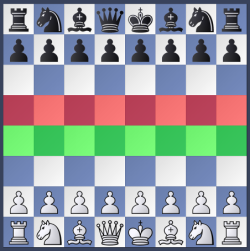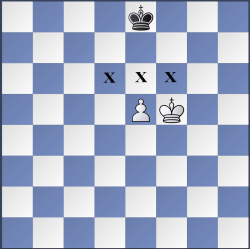In this article I’ll explain the first rule for winning the ending when you have a King and Pawn against your opponent’s lone King. I have previously given some general rules about how to win with a King and Pawn against a King. In this article, I want to get into more detail and show you what to do when your Pawn reaches the fifth rank.
So here are three rules for winning when you have a Pawn (apart from the Rook Pawns, i.e., the Pawns on the a- or h-files) on the 5th rank, and your opponent has no pieces but his King. They are:
- Get your King to one of the critical squares in front of your Pawn
- Push your Pawn to the 6th rank only when your King is on one of the escort squares or when you take the “opposition” by moving the Pawn
- Push your Pawn to the 7th rank only when you do not give check by moving the Pawn
Follow those three rules, and you will always have a good plan for this ending. We’ll review the first of these rules in today’s blog post, and the second and third rules in future blog posts.
Before we explore these rules further, there are a couple of matters that need to be cleared up for beginning players.
What is the “fifth rank?”
When I refer to the fifth rank, I mean the rank that runs from a5 through h5 for White, and a4 through h4 for Black. If we say that the Pawns start on the second rank (a2 through h2 for White, a7 through h7 for Black), then moving a Pawn one step forward puts him on the third rank, another step on the fourth rank, etc., until the Pawn ultimately reaches the 8th rank where it promotes. So the “fifth rank” doesn’t refer to a rank in absolute terms, it refers to a rank in relative terms: it’s one rank for White and another rank for Black. It refers to the fifth row counting from your side of the board. If you’re White, then it’s a5 through h5; but if you’re Black, it’s a4 through h4. See the diagram below.
What are the critical squares for a Pawn on the fifth rank?
A second matter to clear up is the term “critical squares.”
I use the term “critical square” for a square that, if occupied by your King, guarantees a favorable result. (Some writers, Averbakh, for example, call these “key squares.” Quoting Averbakh:
These … squares … are called — in the theory of pawn endings — key squares, since the occupation of any one of them by the white King leads to the attainment of White’s ends (the promotion of the pawn).”
Yuri Averbakh, Chess Endings: Essential Knowledge, p. 40.
For the stronger side (the side with the Pawn), there are three critical squares when the Pawn is on the fifth rank. Those squares are the square directly in front of the pawn and the squares on either side of that square. So for a Pawn on e5 (as in the diagram below), the critical squares are at d6, e6, and f6.
Rule doesn’t apply to Rook Pawns
The Rook Pawns (the Rook Pawns are Pawns that stand on the a- or h-files) often form exceptions to endgame rules. And it is true in this case. The rules given above and explained in this article only apply to Pawns that stand on the b- through g-files. Rook Pawns require different treatment.
Get your King to one of the critical squares in front of Your Pawn
So here’s the rule: for Pawns on your 5th rank, you must first get your King to one of the critical squares, i.e., the square directly in front of the Pawn, or one of the two squares on either side of that square. If you can do that, you can always win.
We’ll look at more rules for this ending in future blog posts.


